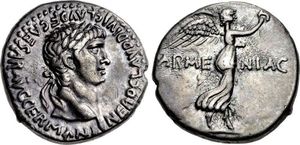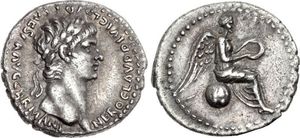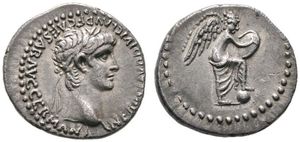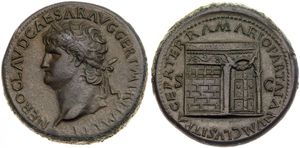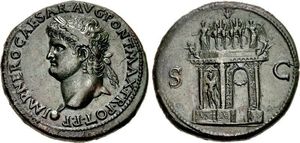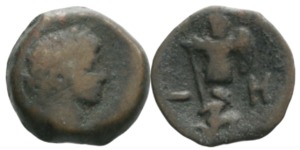Nero 54-68 AD
Description
After Nero’s accession to the throne in 54 AD, Armenians replaced the Iberian prince Rhadamistus, whose mother was daughter of Tigranes IV with Tiridates, who was brother of the Parthian king Vologases I. This was considered as an invasion of Parthians onto Roman territory. Nero decided to send military troops under general Corbulo.
Corbulo was successful in conquering the surrounding territories and thus in 58 AD took over Volandum, which was considered “the strongest city in its province,” according to Tacitus. The neighboring towns and villages had fearfully surrendered. The Romans later took their way towards Artaxata, which was the capital at the time, where they confronted Tiridates with his army. In the instance of the night, Tiridates left behind the inhabitants of the city and withdrew his army. The inhabitants surrendered and the city was levelled to the ground, as the Romans did not have enough convoy to garrison the city. Next year, in 59 AD, Corbulo marched his army towards Tigranacerta, the inhabitants decided to immediately surrender and the city was spared. With such success, Rome was now once again in control of Armenia and had installed Tigranes VI as their new client king.
Tigranes VI was a Cappadocian noble who was raised in Rome and was the great-grandson of Herod the Great. In 61 AD, he decides on invading the Parthian province of Adiabene and a war between Rome and Parthia sparked up again. At the time general Paetus was stationed in Armenia and Corbulo was stationed in Syria. At first Parthians were thinking of invading Syria, but Corbulo had arrayed a big display of military strength, so instead they disastrously defeated Paetus at the battle of Rhandeia. Paetus requested Corbulo’s help. The latter had awaited this situation and had some forces ready. Paetus and Corbulo met at Melitene where Paetus tried to encourage Corbulo to invade Armenia, however Corbulo refused, claiming that he does not have authority and the army is exhausted. Corbulo retired to Syria and Paetus to Cappadocia. A Parthian delegation traveled to Rome in spring of 63 AD, where the meeting resulted in Nero finding out the true extent of the disaster, which Paetus had concealed. Paetus was recalled and Corbulo placed in charge of the Armenian campaign once again. After rearranging and approaching with such a large force, the Arsacid brothers knew what Corbulo is capable of and wanted to negotiate.
Corbulo, following Nero’s instructions, offered to settle the conflict if Tiridates would be willing to accept his crown from Rome. Tiridates knew that it will take a lot of strength to resist the Roman attacks. To Nero this was a benefit as at about the same time he had to deal with the Pisonian Conspiracy. They came to an agreement at the Rhandeia Compromise in 64 AD.
In 66 AD, Tiridates visited Rome for his coronation. Him and his queen approached Neapolis on horseback along with 3,000 horseman. As part of the Parthian custom, the queen wore a golden helmet in order to conceal her face. Tiridates was compensated 800,000 sesterces per day for travel costs until he reached Italy. Nero greeted Tiridates with providing a chariot (as it is not suitable for a king and his wife to travel on horseback), to travel the remainder of their path. Nero ordered for gates of Janus to be shut and the word of peace was spread through the coinage. Nero placed the diadem on Tiridates’s head and the latter was treated with respect and honor and various festivities took place. On return of Tiridates to Armenia, Nero awarded Tiridates with 100 million sesterces and a number of skilled artisans for reconstruction of Artaxata, which later was renamed into Neronia. Tiridates established the Arshakouni dynasty and the peace between Rome and Armenia/Parthia lasted for almost 50 years.
Corbulo was successful in conquering the surrounding territories and thus in 58 AD took over Volandum, which was considered “the strongest city in its province,” according to Tacitus. The neighboring towns and villages had fearfully surrendered. The Romans later took their way towards Artaxata, which was the capital at the time, where they confronted Tiridates with his army. In the instance of the night, Tiridates left behind the inhabitants of the city and withdrew his army. The inhabitants surrendered and the city was levelled to the ground, as the Romans did not have enough convoy to garrison the city. Next year, in 59 AD, Corbulo marched his army towards Tigranacerta, the inhabitants decided to immediately surrender and the city was spared. With such success, Rome was now once again in control of Armenia and had installed Tigranes VI as their new client king.
Tigranes VI was a Cappadocian noble who was raised in Rome and was the great-grandson of Herod the Great. In 61 AD, he decides on invading the Parthian province of Adiabene and a war between Rome and Parthia sparked up again. At the time general Paetus was stationed in Armenia and Corbulo was stationed in Syria. At first Parthians were thinking of invading Syria, but Corbulo had arrayed a big display of military strength, so instead they disastrously defeated Paetus at the battle of Rhandeia. Paetus requested Corbulo’s help. The latter had awaited this situation and had some forces ready. Paetus and Corbulo met at Melitene where Paetus tried to encourage Corbulo to invade Armenia, however Corbulo refused, claiming that he does not have authority and the army is exhausted. Corbulo retired to Syria and Paetus to Cappadocia. A Parthian delegation traveled to Rome in spring of 63 AD, where the meeting resulted in Nero finding out the true extent of the disaster, which Paetus had concealed. Paetus was recalled and Corbulo placed in charge of the Armenian campaign once again. After rearranging and approaching with such a large force, the Arsacid brothers knew what Corbulo is capable of and wanted to negotiate.
Corbulo, following Nero’s instructions, offered to settle the conflict if Tiridates would be willing to accept his crown from Rome. Tiridates knew that it will take a lot of strength to resist the Roman attacks. To Nero this was a benefit as at about the same time he had to deal with the Pisonian Conspiracy. They came to an agreement at the Rhandeia Compromise in 64 AD.
In 66 AD, Tiridates visited Rome for his coronation. Him and his queen approached Neapolis on horseback along with 3,000 horseman. As part of the Parthian custom, the queen wore a golden helmet in order to conceal her face. Tiridates was compensated 800,000 sesterces per day for travel costs until he reached Italy. Nero greeted Tiridates with providing a chariot (as it is not suitable for a king and his wife to travel on horseback), to travel the remainder of their path. Nero ordered for gates of Janus to be shut and the word of peace was spread through the coinage. Nero placed the diadem on Tiridates’s head and the latter was treated with respect and honor and various festivities took place. On return of Tiridates to Armenia, Nero awarded Tiridates with 100 million sesterces and a number of skilled artisans for reconstruction of Artaxata, which later was renamed into Neronia. Tiridates established the Arshakouni dynasty and the peace between Rome and Armenia/Parthia lasted for almost 50 years.

